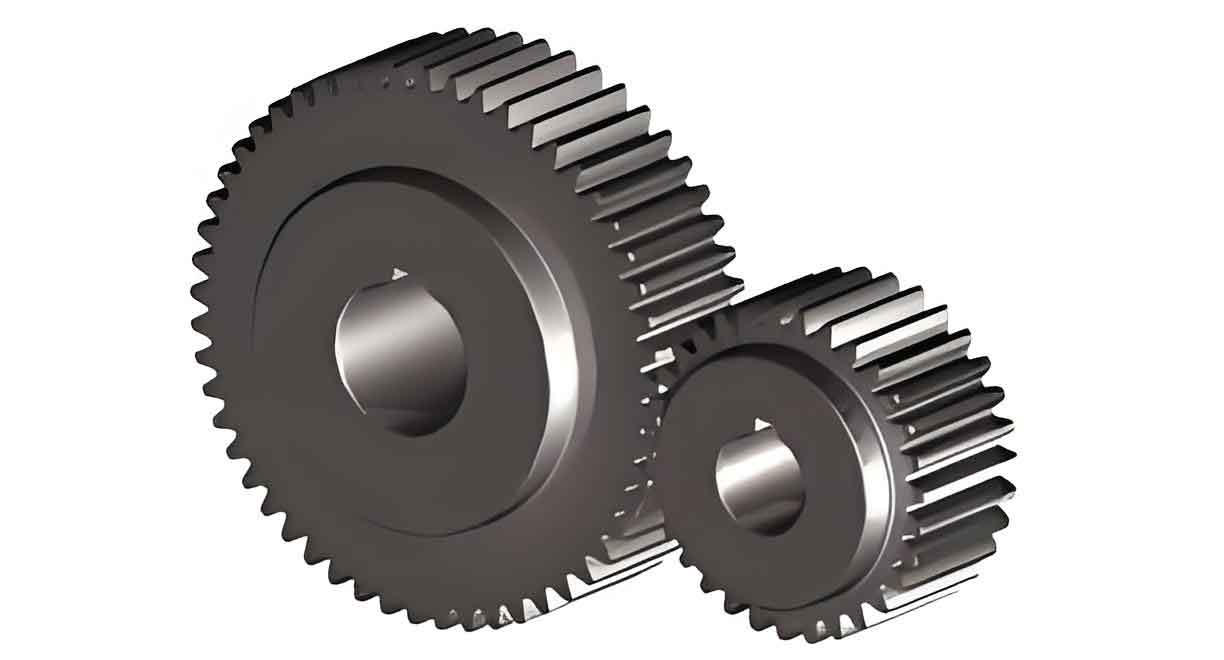This study investigates the meshing impact mechanisms and nonlinear dynamics of spur gear pairs under multi-state engagement conditions. A comprehensive dynamic model incorporating time-varying parameters and backlash effects is developed to analyze switching impacts and boundary collisions.

1. Time-Varying Parameters and Impact Identification
The spur gear system exhibits five engagement states: double/single tooth drive-side meshing, disengagement, and double/single tooth back-side contact. Key time-varying parameters include:
| Parameter | Expression |
|---|---|
| Mesh Stiffness | $$k(t) = \frac{1}{\sum_{i=1}^2 \left(\frac{1}{k_{hi}} + \frac{1}{k_{fi}} + \frac{1}{k_{bi}} + \frac{1}{k_{si}}\right)}$$ |
| Load Distribution | $$L_j(t) = \begin{cases} \frac{\eta_C – t}{\eta_C – \eta_A} & t \in [\eta_A, \eta_C] \\ 1 & t \in (\eta_C, \eta_D) \\ \frac{\eta_E – t}{\eta_E – \eta_D} & t \in [\eta_D, \eta_E] \end{cases}$$ |
2. Impact Force Modeling
The switching impact duration between single/double tooth engagement is derived using Hertzian contact theory:
$$t_s = 1.88\left(\frac{m_e}{k(t)}\right)^{2/5}v_0^{-1/5}$$
Boundary impact forces at drive-side (x = D0) and back-side (x = -D0) are calculated through energy conservation:
$$F_{imp} = \left(\frac{5}{4}k(t)m_e(1 – r_e^2)v_0^2\right)^{3/5}$$
3. Nonlinear Dynamic Model
The dimensionless governing equation considering multiple engagement states is established:
$$m_e\ddot{x} + c_m\dot{x} + k(t)f(x) = F_m + F_h(t) + \sum_{j=1}^2 F_{imp}^j(t)$$
Where the piecewise displacement function accounts for backlash effects:
$$f(x) = \begin{cases}
x – D_0 & x \geq D_0 \\
0 & |x| < D_0 \\
x + D_0 & x \leq -D_0
\end{cases}$$
4. Dynamic Characteristics Analysis
The bifurcation behavior reveals eight distinct motion states under parameter variations:
| Parameter | Range | Dynamic Behavior |
|---|---|---|
| Mesh Frequency (ω) | 0.6-1.5 | Period 1 → Chaos → Period 2 transitions |
| Load Coefficient (F) | 0.02-0.2 | Back-side contact → Stable drive-side meshing |
| Backlash (D0) | 0.05-1.0 | Impact-dominated → Smooth transitions |
Key findings from TLE (Top Lyapunov Exponent) analysis:
$$TLE = \lim_{n \to \infty}\frac{1}{n}\sum_{i=0}^{n-1}\ln|J(x_i)|$$
Where Jacobian matrix J determines system stability. Negative TLE values indicate periodic motions, while positive values signify chaotic behavior.
5. Case Studies
Five representative cases demonstrate the spur gear system’s complex dynamics:
| Case | Parameters | State Transitions |
|---|---|---|
| 1 | ω=1.2, F=0.1 | Pure drive-side meshing |
| 2 | ω=0.78, F=0.15 | Meshing → Disengagement |
| 3 | ω=1.2, F=0.06 | Drive-side → Back-side impacts |
The spur gear system exhibits velocity jumps at engagement boundaries:
$$\Delta \dot{x} = \sqrt{\dot{x}^2 – \frac{2}{m_e}(F_{imp} – F_N)}$$
Where FN represents the quasi-static contact force. Tooth separation occurs when Fimp > FN.
6. Parameter Sensitivity
Critical parameters affecting spur gear dynamics are ranked by sensitivity:
$$S_p = \frac{\partial \ddot{x}}{\partial p}\bigg|_{p_0}$$
- Mesh frequency (Sω = 2.35)
- Backlash (SD0 = 1.87)
- Load coefficient (SF = 1.42)
The proposed model provides theoretical foundations for optimizing spur gear designs against vibration and noise through impact control.
